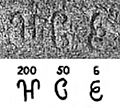6 facts for kids
The year 6 AD (which means "Anno Domini" or "in the year of the Lord") was an ordinary year in the Julian calendar. It started on a Friday. If we used today's Gregorian calendar, it would have started on a Sunday. This year was the 6th year of the 1st century.
This page is about the year 6 AD. For the actual number, see six.
| Millennium: | 1st millennium |
|---|---|
| Centuries: | 1st century BC – 1st century – 2nd century |
| Decades: | 20s BC 10s BC 0s BC – 0s – 10s 20s 30s |
| Years: | 3 AD 4 AD 5 AD – 6 AD – 7 AD 8 AD 9 AD |
| Gregorian calendar | AD 6 VI |
| Ab urbe condita | 759 |
| Assyrian calendar | 4756 |
| Balinese saka calendar | N/A |
| Bengali calendar | −587 |
| Berber calendar | 956 |
| Buddhist calendar | 550 |
| Burmese calendar | −632 |
| Byzantine calendar | 5514–5515 |
| Chinese calendar | 乙丑年 (Wood Ox) 2702 or 2642 — to — 丙寅年 (Fire Tiger) 2703 or 2643 |
| Coptic calendar | −278 – −277 |
| Discordian calendar | 1172 |
| Ethiopian calendar | −2 – −1 |
| Hebrew calendar | 3766–3767 |
| Hindu calendars | |
| - Vikram Samvat | 62–63 |
| - Shaka Samvat | N/A |
| - Kali Yuga | 3106–3107 |
| Holocene calendar | 10006 |
| Iranian calendar | 616 BP – 615 BP |
| Islamic calendar | 635 BH – 634 BH |
| Javanese calendar | N/A |
| Julian calendar | AD 6 VI |
| Korean calendar | 2339 |
| Minguo calendar | 1906 before ROC 民前1906年 |
| Nanakshahi calendar | −1462 |
| Seleucid era | 317/318 AG |
| Thai solar calendar | 548–549 |
| Tibetan calendar | 阴木牛年 (female Wood-Ox) 132 or −249 or −1021 — to — 阳火虎年 (male Fire-Tiger) 133 or −248 or −1020 |
Contents
Major Events in 6 AD
Roman Empire News
- Herod Archelaus, who ruled parts of Samaria, Judea, and Edom, was removed from his position. He was sent away to a place called Vienne in Gaul (which is modern-day France).
- Judea and Moesia became new Roman provinces. This meant they were now directly controlled by Rome.
- The Roman region of Syria was protected by several powerful Roman armies, known as legions. These included Legio X Fretensis, Legio III Gallica, Legio VI Ferrata, and Legio XII Fulminata.
- Emperor Augustus created a special fund called the aerarium militare. This fund was set up to pay bonuses to Roman soldiers when they retired from the army.
- The Roman general Tiberius set up his main camp at Carnuntum. From there, he planned to fight against a powerful leader named Maroboduus. The Roman army Legio XX Valeria Victrix joined Tiberius in this fight.
- People from Pannonia, Dalmatia, and other Illyrian tribes started a rebellion against Rome. Tiberius eventually defeated them after a tough three-year war.
- The city of Wiesbaden in modern-day Germany began as a Roman fort that was started this year.
- Caecina Severus was made the new governor of Moesia.
- Publius Sulpicius Quirinius became the Governor of Syria. He was also in charge of Judea.
- Quirinius carried out a census (a count of the population) in Judea. This census caused a revolt led by Judas of Galilee. He was supported by a group called the Pharisees. The rebellion was stopped, but it led to the start of the Zealot movement. Zealots believed that God was their only ruler.
- There was a shortage of food in Rome. To help the people, Emperor Augustus doubled the amount of grain given out to everyone.
- A huge fire broke out in Rome. Because of this disaster, a new system of barracks (buildings for soldiers or firefighters) was created. This helped Rome respond much faster to emergencies like fires.
- Emperor Augustus sent his adopted son, Agrippa Postumus, away to the island of Pianosa.
- Marcus Aemilius Lepidus and Lucius Arruntius became the Roman consuls. Consuls were the highest elected officials in the Roman Republic.
- Theophilus became the Archon of Athens. An Archon was a chief magistrate in ancient Athens.
Events in Africa
- Juba II, the king of Mauretania and Numidia, married Glaphyra. She was a princess from Cappadocia. This marriage didn't last long because Glaphyra fell in love with Herod Archelaus and moved to Judea. This was one reason why Herod was removed from power.
- After Orodes III was removed from power, Rome appointed Vorones I as the new King of Parthia. However, the important leaders in Parthia did not accept him. They invited Artabanus II, another member of the royal family, to become king. This led to a civil war in Parthia.
Events in Asia
- Ru Zi Ying became the new ruler of the Han dynasty in China. This also marked the beginning of the Jushe era in Chinese history.
- From this year, people who wanted to work in the government in China had to take special civil-service examinations. This was a way to make sure officials were skilled and knowledgeable.
- The imperial Liu family in China started to suspect that Wang Mang had bad intentions. They encouraged farmers to rebel during Ru Zi Ying's rule. The first of these rebellions was led by Liu Chong.
People Born in 6 AD
- Jesus: This is often considered the latest possible year for his birth, based on the Quirinius census.
- Nero Caesar: He was the son of Germanicus and Agrippina the Elder. (He died in 30 AD).
- Milonia Caesonia: She later became a Roman empress. (She died in 41 AD).
People Who Died in 6 AD
- February 3 – Emperor Ping of Han: He was the emperor of the Han dynasty in China. (Born in 9 BC).
- Cleopatra Selene II: She was an Egyptian ruler of Cyrenaica and Libya. (Born in 40 BC).
- Orodes III: He was briefly the emperor of Parthia.
Images for kids
-
A cube has six faces.
-
An X-ray of a polydactyl human hand with six fingers.
-
The first appearance of the number 6 is in the Edicts of Ashoka around 250 BCE. These are Brahmi numerals, which are ancestors of the numbers we use today.
-
The first known digit "6" in the number "256" in Ashoka's Minor Rock Edict No.1 in Sasaram, around 250 BCE.
-
The cells of a beehive are six-sided.
See also
 In Spanish: Seis para niños
In Spanish: Seis para niños

All content from Kiddle encyclopedia articles (including the article images and facts) can be freely used under Attribution-ShareAlike license, unless stated otherwise. Cite this article:
6 Facts for Kids. Kiddle Encyclopedia.





